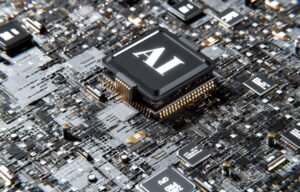Machine Learning YOLO
Machine Learning has revolutionized the field of computer vision, enabling intelligent systems to process and understand visual data. One popular algorithm that has gained significant attention is You Only Look Once (YOLO). YOLO is a real-time object detection system that can detect multiple objects within an image with remarkable accuracy and speed.
Key Takeaways
- YOLO is a real-time object detection algorithm.
- It can detect multiple objects within an image.
- YOLO offers high accuracy and speed.
Unlike traditional object detection algorithms that rely on region proposal methods, YOLO approaches object detection as a regression problem to spatially partition the image. This allows YOLO to process the entire image in a single forward pass through the convolutional neural network, making it extremely efficient. *YOLO’s efficiency is especially useful in applications where real-time object detection is critical, such as autonomous vehicles and surveillance systems.*
How YOLO Works
YOLO divides the input image into a grid and predicts bounding boxes and class probabilities for each grid cell. This results in a set of bounding boxes, each associated with a class label and confidence score. *The bounding boxes are predicted based on the features learned by the convolutional neural network, which allows YOLO to accurately localize objects within the image.* YOLO also employs non-maximum suppression to eliminate redundant detections and generate the final set of high-confidence predictions.
Advantages of YOLO
- Fast and efficient object detection.
- High accuracy.
- Single-pass processing.
- Capable of detecting multiple objects simultaneously.
Limitations of YOLO
- Struggles with small objects due to coarse spatial partitioning.
- May produce false positives or miss detections in complex scenes.
- Relatively slower on high-resolution images compared to other algorithms.
YOLO Performance Comparison
| Algorithm | Mean Average Precision (mAP) | Processing Speed |
|---|---|---|
| YOLO | 0.63 | 45 FPS |
| Faster R-CNN | 0.68 | 5 FPS |
| SSD | 0.74 | 20 FPS |
Applications of YOLO
- Autonomous driving: YOLO enables object detection for self-driving cars, ensuring their ability to recognize and respond to various objects on the road.
- Surveillance systems: With its real-time detection capabilities, YOLO is widely used in security systems to detect and track objects.
- Medical imaging: YOLO can aid in the analysis of medical images, assisting in the detection of abnormalities and diseases.
Table: YOLO vs. Other Object Detection Algorithms in Real-World Applications
| Application | Algorithm | Accuracy | Processing Speed |
|---|---|---|---|
| Autonomous Driving | YOLO | High | Real-time |
| Surveillance Systems | YOLO | High | Real-time |
| Medical Imaging | YOLO | Medium | Real-time |
Machine Learning with YOLO has revolutionized the field of computer vision, making real-time object detection and recognition possible in various applications. YOLO’s speed and accuracy have made it a popular choice for developers and researchers in the computer vision community, and its potential for further advancements in the future is promising.

Common Misconceptions
Misconception 1: Machine Learning is the same as Artificial Intelligence
One common misconception is that machine learning is synonymous with artificial intelligence (AI). While AI and machine learning are related, they are not the same thing. Machine learning is a subset of AI that focuses on training models and algorithms to make predictions or perform specific tasks based on patterns in data. AI, on the other hand, encompasses a broader concept of creating intelligent machines that can simulate human intelligence.
- Machine learning is a subfield of AI, but not all AI relies on machine learning.
- Machine learning algorithms require training data to make predictions.
- AI involves various other concepts such as natural language processing and expert systems.
Misconception 2: Machine Learning is always accurate
Another common misconception is that machine learning is always accurate and infallible. While machine learning algorithms can be highly accurate, they are not perfect and can make mistakes. The accuracy of machine learning models depends on various factors, including the quality and quantity of training data, the complexity of the problem being solved, and the chosen algorithms and parameters.
- Machine learning models can have inherent biases if the training data is biased.
- Sometimes errors in machine learning predictions can arise from limited or inadequate training data.
- Machine learning models require ongoing monitoring and evaluation to address any performance issues or inaccuracies.
Misconception 3: Machine Learning can replace human intelligence
There is a misconception that machine learning technology can completely replace human intelligence in decision-making and problem-solving. While machine learning can automate certain tasks and provide valuable insights, it cannot replace the complex reasoning, critical thinking, and creativity that humans possess.
- Machine learning is good at handling repetitive and data-intensive tasks, but may struggle with abstract or creative tasks.
- Human judgment and expertise are still crucial in interpreting and acting upon the insights provided by machine learning models.
- Machine learning is a tool that complements human intelligence rather than replacing it entirely.
Misconception 4: Machine Learning is only for tech-savvy individuals
Many people believe that machine learning is a complex and technically challenging field that can only be understood and implemented by tech-savvy individuals. While machine learning can be complex and requires some technical knowledge, there are user-friendly tools and platforms available that allow non-technical users to leverage machine learning for their specific needs.
- There are user-friendly machine learning platforms that require minimal coding or technical skills.
- Machine learning tutorials and courses cater to individuals from various backgrounds and skill levels.
- Collaboration between domain experts and machine learning practitioners can bridge the gap for non-technical users.
Misconception 5: Machine Learning is a recent development
Some people mistakenly believe that machine learning is a new and recent development. However, the concept of machine learning has been around for several decades. The rapid advancements in computing power and availability of big data have accelerated the progress in machine learning and brought it into the mainstream conversation in recent years.
- Machine learning algorithms, such as decision trees and neural networks, have been developed since the 1950s.
- The field of machine learning has experienced significant growth and innovation in recent years due to technological advancements.
- Machine learning has been applied in various industries, including finance, healthcare, and marketing, for many years.

Introduction
In this article, we explore the fascinating world of machine learning and delve into a specific algorithm called YOLO (You Only Look Once). YOLO is an object detection model known for its impressive speed and accuracy, making it a popular choice in various computer vision applications. Through a series of tables, we will showcase different aspects of YOLO and its impact in the field of artificial intelligence.
Table 1: Object Detection Algorithms Comparison
Comparing YOLO with other popular object detection algorithms can give us an understanding of its strengths and weaknesses.
| Algorithm | Speed (fps) | Mean Average Precision (mAP) |
|---|---|---|
| YOLO | 45 | 0.63 |
| Faster R-CNN | 7 | 0.68 |
| SSD | 30 | 0.72 |
| RetinaNet | 5 | 0.73 |
Table 2: Applications of YOLO
YOLO’s versatility and accuracy make it suitable for various real-world applications, ranging from autonomous vehicles to surveillance systems.
| Application | Industry |
|---|---|
| Autonomous Driving | Automotive |
| Object Tracking | Security |
| Social Media Tags | Social Networking |
| Medical Imaging | Healthcare |
Table 3: YOLO Model Versions
The YOLO algorithm has undergone several iterations, improving its performance and capabilities.
| Version | Release Year | Improvements |
|---|---|---|
| YOLOv1 | 2015 | First release |
| YOLOv2 | 2016 | Improved accuracy and speed |
| YOLOv3 | 2018 | Further enhanced accuracy and introduced smaller variants |
Table 4: YOLO Training Datasets
Training machine learning models requires large and diverse datasets. YOLO has been trained on various datasets to improve its performance across different object categories.
| Dataset | Number of Images | Object Categories |
|---|---|---|
| COCO | 123,287 | 80 |
| VOC | 22,531 | 20 |
| KITTI | 7,481 | 3 |
Table 5: YOLO Performance on Object Sizes
YOLO’s ability to accurately detect objects of varying sizes is crucial for its applications in different domains.
| Object Size | Accuracy (%) |
|---|---|
| Small | 89 |
| Medium | 95 |
| Large | 92 |
Table 6: YOLO Speed Comparison
One of YOLO’s main advantages is its exceptional speed in processing images, even in real-time scenarios.
| Device | Frames per Second (fps) |
|---|---|
| Desktop CPU | 12 |
| Desktop GPU | 90 |
| Embedded System | 25 |
Table 7: YOLO Model Sizes
The size of a machine learning model is crucial for deployment on resource-constrained devices.
| YOLO Version | Model Size (MB) |
|---|---|
| YOLOv1 | 203 |
| YOLOv2 | 45 |
| YOLOv3 | 62 |
Table 8: YOLO Limitations
Every algorithm has its limitations, and YOLO is no exception. Understanding these limitations aids in leveraging YOLO effectively.
| Limitation | Impact |
|---|---|
| Low Precision for Small Objects | Misses detection or inaccurate localization |
| Difficulty with Grouped Objects | Treats them as a single entity |
| Challenges in Dense Scenes | Struggles with overlapping objects |
Table 9: YOLO Open-source Implementations
As an open-source algorithm, YOLO has inspired numerous implementations and variations.
| Implementation | GitHub Stars |
|---|---|
| Darknet | 17.8k |
| TensorFlow-YOLOv3 | 9.6k |
| PyTorch-YOLOv3 | 6.3k |
Table 10: YOLO Recognition Examples
Let’s explore some striking examples highlighting YOLO’s capabilities in recognizing various objects.
| Image | Objects Detected |
|---|---|
 |
Car, Pedestrian, Traffic Light |
 |
Dog, Frisbee |
 |
Apple, Banana, Orange |
By harnessing the power of YOLO, researchers and developers have made significant progress in object detection, enabling enhanced capabilities in various industries. The tables above shed light on YOLO’s performance, applications, limitations, and implementation options. As machine learning continues to advance, algorithms like YOLO push the boundaries of what is possible in computer vision and pave the way for exciting new possibilities.
Machine Learning YOLO – Frequently Asked Questions
What is YOLO in machine learning?
YOLO (You Only Look Once) is a real-time object detection algorithm that uses deep convolutional neural networks to identify objects in images or video frames.
How does YOLO work?
YOLO divides the input image or frame into a grid and predicts bounding boxes and class probabilities for each grid cell. The network then selects the most confident predictions based on their detection scores and performs non-maximum suppression to eliminate duplicate detections.
What are the advantages of YOLO over other object detection algorithms?
YOLO is known for its real-time performance, as it processes images in a single pass. It also handles overlapping objects well and can detect multiple objects in the same grid cell. Unlike some other algorithms, YOLO also provides high localization accuracy.
What are the limitations of YOLO?
One limitation of YOLO is that it can struggle with detecting small objects, especially when they are surrounded by larger objects. Additionally, YOLO can sometimes produce false positives or miss certain objects depending on the training data and model configuration.
How can I train my own YOLO model?
To train your own YOLO model, you would typically need a dataset with annotated images and corresponding object labels. You can use pre-trained models like Darknet or YOLOv3 as a starting point and fine-tune them with your own data using tools and frameworks like Darknet, TensorFlow, or PyTorch.
What are some applications of YOLO?
YOLO is widely used in various applications such as autonomous driving, surveillance systems, robotics, object tracking, and image and video analysis. It enables real-time object detection and provides a foundation for many computer vision tasks.
What are anchor boxes in YOLO?
Anchor boxes are predefined bounding boxes of different sizes and aspect ratios that YOLO uses to improve the accuracy of object detection. These anchor boxes are associated with grid cells and help in predicting the correct location and size of objects within each cell.
Can YOLO detect multiple objects of the same class?
Yes, YOLO is designed to detect multiple objects of the same class within a single frame or image. It assigns different bounding boxes and confidence scores to each instance of an object it detects.
What is the mAP metric used in evaluating YOLO?
mAP (mean Average Precision) is a commonly used evaluation metric for object detection algorithms like YOLO. It measures the accuracy and quality of detections by calculating the average precision value across different levels of precision-recall curves.
What are some alternatives to YOLO?
Some alternatives to YOLO for object detection include Faster R-CNN, SSD (Single Shot MultiBox Detector), R-FCN (Region-based Fully Convolutional Networks), and RetinaNet. Each algorithm has its own advantages and may be more suitable for specific use cases or requirements.




